Advanced technologies to keep geriatric spinal complications at bay
Srinagar, July 24, 2021: With increasing age, Time old injuries and bad habits take their toll on the spine, but with new treatments and advanced diagnostic tests such complications can be kept at bay. There are several diseases that can lead to low back pain in the ageing spine including osteoporosis, disc degeneration (deterioration), lumbar spinal stenosis (narrowing) and spondylolisthesis (displacement of a vertebra by the one above it).
For patients with a history of back pain and who are currently experiencing symptoms the first step is proper diagnostic testing. A series of imaging test over a period of time can help neurosurgeons monitoring the disease progression and determine the correct course of treatment. A common misconception is that a patient is too “old” for surgery.
The spine goes through ageing process just like any other part of the body. Many of these conditions reduce the quality of life and patients tend to just accept them as a consequence of getting older. These patients need to see a neurosurgeon early to develop a long-range treatment plan. Spine surgery provides great relief to patient well into their 80s.
Studies have shown that age is not a major factor in determining whether someone will benefit from surgery, although some conditions associated with age, such as high blood pressure or diabetes can influence their surgical risks.
Degeneration in the disc is normal and is part of the ageing process. Osteoarthritis (disc degeneration) is one of the most common disorders in the lower spine. As the body ages, the disc in the spine dry out and lose their ability to act shock absorbers and the problem appears when these discs pinch and put pressure on the nearby nerve roots or spinal cord.
“Treatment plans for patients with disc degeneration in the spine are often long and conservative with the focus on relieving the pressure on the nerve. Doctors will often prescribe an array of treatments including physiotherapy and anti- inflammatory drugs. Surgery is only considered when there is a neurological problem in the form of weakness or paralysis of a part, if urinary problems appear or if there is failure of conservative (non-operative) treatment.” Said Dr Bipin Walia, Principal Director & Head Department of Neurosurgery, Max Super specialty Hospital, Saket, New Delhi
While Lumbar Spinal Stenosis is one of the common complications among the geriatric population, where the spinal canal is narrowed, compressing the spinal cord and nerve roots. This results in claudication where a patient may develop symptoms such as heaviness or pain in the legs and buttocks and numbness.
Degeneration and lumbar spinal stenosis are often part of similar disease complex and therefore any surgery often deals with both the problems. Degeneration in the spine can lead to spondylolisthesis, a condition characterized by the slippage of a vertebra in the spine. Degeneration, lumbar spinal stenosis and spondylolisthesis may occur independently or together as part of the same disease complex.
“Like all other spine disorders, conservative treatment often provides relief and pain doesn’t become severe unless a nerve root is irritated. Surgery can deal with all the issues and over 80 percent of patients are satisfied with the results due to the dramatic improvement in their quality of life after spine surgery. However, over 80 percent of LSS patients have dramatic increase in their quality of life after spine surgery and can return to their active lifestyle.” Added Dr Bipin
Osteoporotic fractures are one of the major factors for spinal complications, especially among post-menopausal women due to the loss of bone mineral density, strength and porosity raising the susceptibility to fracture. It is a common cause of vertebral (spinal) fractures and a majority of these patients will complain of back pain, deformity, stiffness and rarely neurological symptoms. Such fractures are common and seen in atleast one in four women above the age of 50 years.
“Conventional treatment of osteoporotic vertebral fractures has been almost exclusively non- operative with bed rest, analgesia, non- steroidal anti- inflammatory agents and physical therapy with external bracing. Where conservative treatment fails to alleviate pain, a simple procedure called vertebroplasty or kyphoplasty can be undertaken in which bone cement is injected into the fracture vertebral body to relieve pain and correct deformity. Surgery is one of many possible solutions the neurosurgeon has available and today with the availability of minimally invasive spine surgery (MISS), surgery is safe, reliable and with minimal tissue injury.” He added







